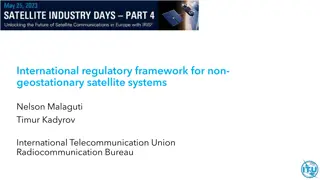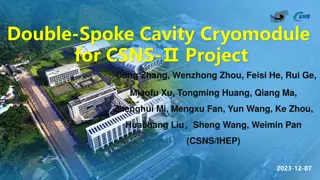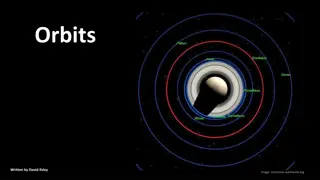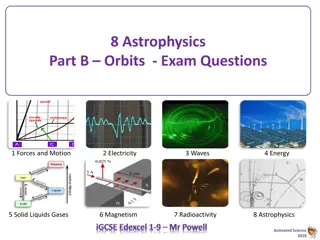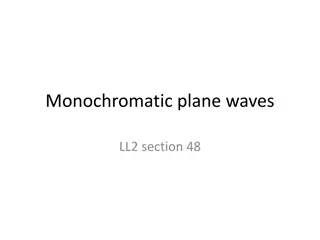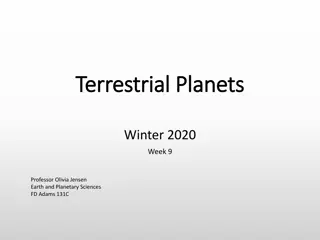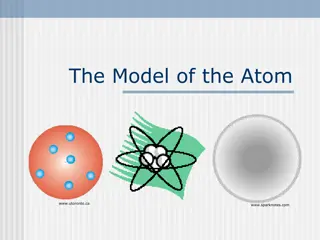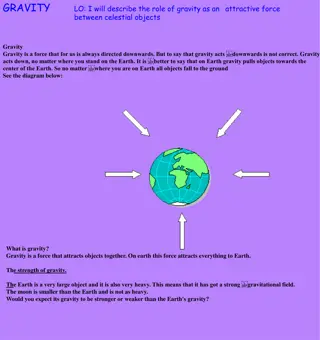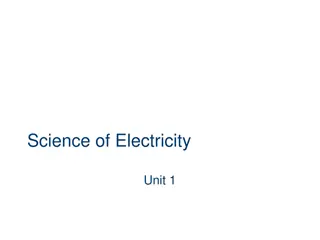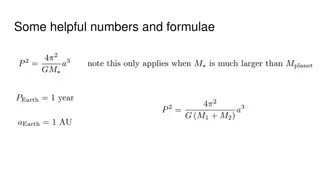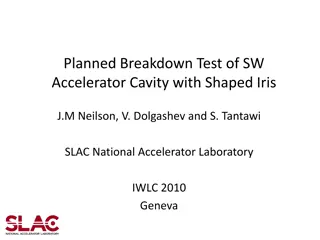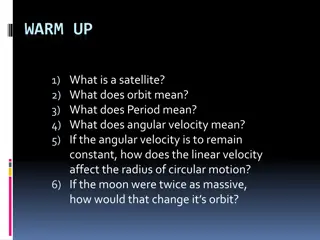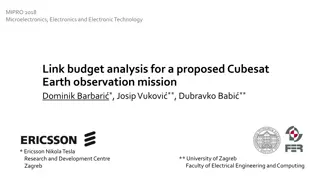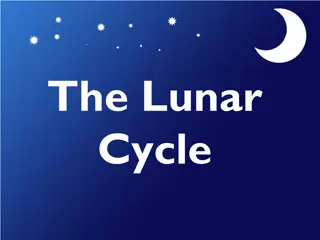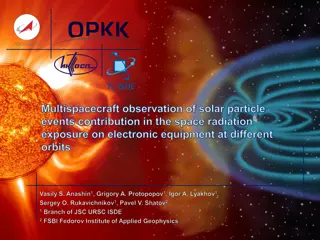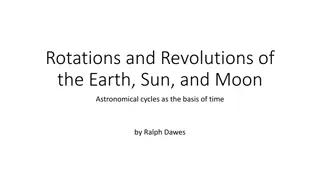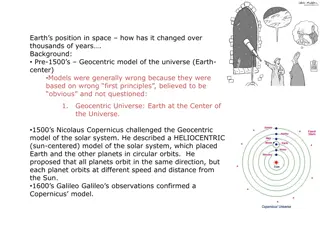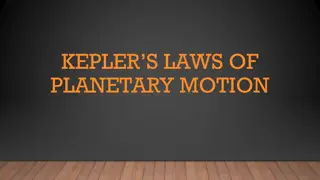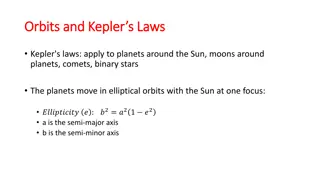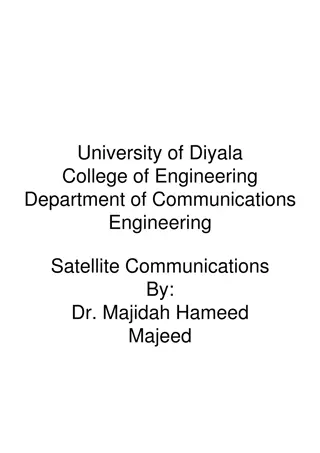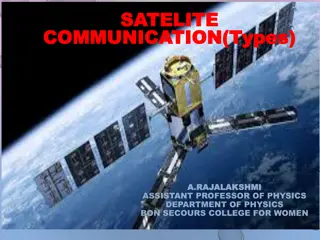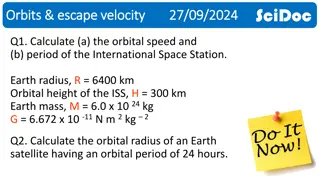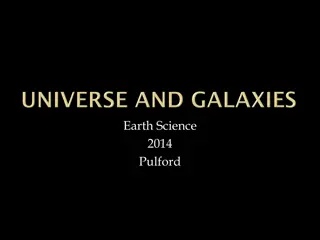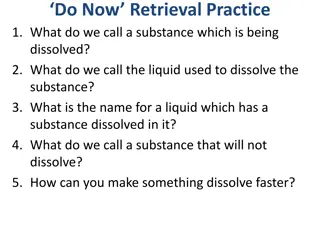Satellites and Orbits
The realm of satellites and orbits, covering topics such as Kepler's Laws, meteorological satellite orbits, the history of satellite remote sensing, and different types of orbits including geostationary and sun-synchronous orbits. Explore the significance of inclination angles, orbital speeds, and d
3 views • 22 slides
International Regulatory Framework for Non-Geostationary Satellite Systems
Understanding the international regulatory framework for non-geostationary satellite systems, including coordination for protection of existing services, spectrum access/use laws, satellite frequencies and services, and mechanisms for protecting geostationary satellite orbits. The regulations aim to
2 views • 17 slides
Understanding Eclipses: The Celestial Dance Between the Sun, Moon, and Earth
Eclipses are fascinating astronomical events where the Moon comes between the Sun and Earth, causing either a solar eclipse or lunar eclipse. This summary delves into the different types of eclipses, such as total and partial solar eclipses, the Moon's elliptical orbit, and the intricate movements t
4 views • 25 slides
Introduction to Kinematics and Dynamics of Machines in Industrial Engineering Department
This chapter introduces the mechanisms and machines in industrial engineering focusing on the kinematics and dynamics of machines. The concept of slider-crank mechanisms and their inversions are explored, providing applications such as reciprocating engines, rotary engines, and hand pumps. Additiona
2 views • 19 slides
Advanced Cryomodule Technology for China's Spallation Neutron Source Upgrade
This article discusses the development of a Double-Spoke Cavity Cryomodule for the China Spallation Neutron Source (CSNS) project. It covers the structure of the cryomodule, integration processes, future work, and details about the CSNS beam parameters and upgrade scheme. The content includes images
0 views • 19 slides
Understanding Orbits and Gravity in Space
Explore the concept of orbits and gravity in space by following the trajectory of a satellite above Earth. Learn how gravity keeps the satellite in a perpetual state of orbit, moving at a constant speed parallel to the ground due to the Earth's round shape. Discover how varying speeds affect orbit s
0 views • 34 slides
Understanding Orbits and Motion in Astrophysics
Explore the concept of orbits and motion in astrophysics, covering gravitational forces, planetary orbits, orbital speeds, and celestial phenomena like lunar eclipses. Delve into how objects move in space, the relationships between orbital speed, radius, and time period, and the dynamics of celestia
0 views • 14 slides
Enhancing Cardiorespiratory Endurance Training Techniques
Dive into Chapter 8 focusing on Developing Cardiorespiratory Endurance. Explore important vocabulary, cardiorespiratory fitness tests, alternate evaluations, and aerobic activities. Learn about various tests, such as the Steady-State Walk Test and Cooper's 1.5 Mile Run Test, to assess and improve en
0 views • 7 slides
Magnetic Field Problems: Protons, Wires, and Charged Ions
Solve various problems related to magnetic fields, including determining forces on protons, calculating magnetic forces on wires with currents, finding the radius of paths for charged ions in magnetic fields, and more. Understand concepts such as magnetic forces, circular orbits, and interactions be
0 views • 10 slides
Understanding Atomic Structure: Electrons, Energy Levels, and Historical Models
The atomic model describes how electrons occupy energy levels or shells in an atom. These energy levels have specific capacities for electrons. The electronic structure of an atom is represented by numbers indicating electron distribution. Over time, scientists have developed atomic models based on
0 views • 5 slides
Understanding the Gaussian Distribution and Its Properties
This insightful content dives into the Gaussian Distribution, including its formulation for multidimensional vectors, properties, conditional laws, and examples. Explore topics like Mahalanobis distance, covariance matrix, elliptical surfaces, and the Gaussian distribution as a Gaussian function. Di
0 views • 19 slides
Exploring the Twelvefold Way in Combinatorics
The Twelvefold Way in combinatorics classifies enumerative problems related to finite sets, focusing on functions from set N to set X under various conditions like injective or surjective. It considers equivalence relations and orbits under group actions, providing a systematic approach to counting
4 views • 15 slides
Understanding Monochromatic Plane Waves in Electromagnetic Theory
Explore the characteristics and properties of monochromatic plane waves in electromagnetic theory, including their spatial distribution, propagation in the positive X direction, wavelength, linear and non-linear operations, polarization direction, elliptical and circular polarization, and the relati
0 views • 15 slides
Exploring Satellite Orbits and Space Missions
This content covers a variety of topics related to satellites, including geosynchronous orbit, satellite history, organisms sent to orbit, types of orbits, orbital altitudes, and current satellite usage. It delves into the history of satellite launches, types of orbits, and the functions of satellit
0 views • 20 slides
Understanding Orbital Dynamics: Kepler's Laws and Newtonian Gravity
Delve into the fascinating world of orbital dynamics as we explore Kepler's Laws and Newtonian Gravity. From understanding the elliptical orbits of planets around the Sun to uncovering the role of gravity in shaping celestial motion, this journey will illuminate the fundamental principles governing
0 views • 18 slides
European Deep Space Surveillance and Tracking Collaboration
EU Space Surveillance and Tracking program involves five European nations collaborating to assess and reduce risks to European spacecraft, provide early warnings for re-entries and space debris, and prevent space debris proliferation. Available deep space sensors, such as optical telescopes, are uti
1 views • 8 slides
Landice Elliptical E9 Cardio Equipment - Key Features and Control Panel Functions
Landice E9 Elliptical is a high-quality cardio equipment with a weight capacity of 500 lbs. It features a robust construction with medical-grade side rails, a center drive system, and a fixed 21" stride length. The console offers various program options, heart-rate control programs, and user-defined
0 views • 28 slides
Evolution of Atomic Models: From Thomson to Bohr
Scientists from J.J. Thomson to Niels Bohr made groundbreaking discoveries in understanding the structure of the atom. Thomson's plum-pudding model was followed by Rutherford's nuclear model, revealing the nucleus. Bohr introduced the concept of discrete energy levels and orbits for electrons. These
4 views • 22 slides
Understanding Gravity: A Fundamental Force in the Universe
Gravity is a ubiquitous force that attracts celestial objects towards each other, playing a crucial role in keeping planets in their orbits around the Sun and moons around their parent planets. This force, described by Newton's laws, is responsible for phenomena like tides and maintaining the motion
0 views • 7 slides
Understanding Electricity at the Atomic Level
Explore the fascinating world of electricity at the atomic level, delving into concepts such as the movement of electrons, components of an atom, electron orbits, atomic numbers, and the behavior of elements like copper and sulfur. Discover how these fundamental principles shape the properties of ma
0 views • 28 slides
Exploring Vocabulary Through Images: Definitions from James Baldwin
Discover the rich vocabulary presented through visually appealing images with definitions from the renowned writer James Baldwin. From elliptical and expatriate to profound and serene, each word is beautifully depicted and explained. Delve into the intrinsic qualities of these terms and learn about
0 views • 8 slides
Understanding Different Types of Leaves, Leaf Shapes, Venation Patterns, Flowers, and Plant Sexuality
Explore the world of leaves through simple, compound, and various shapes like acicular, cordate, lanceolate, elliptical, linear, oblong, and ovate. Discover the different venation patterns and learn about flower anatomy, including floral parts and plant sexuality with perfect and imperfect flowers.
0 views • 6 slides
Exploring Planet Nine: Orbits, Mass, and Kepler's Law
Astronomers speculate about Planet Nine, a massive body in the distant Solar System. Calculations are made about its orbit period, potential interactions with a black hole, and changes in period if it were more massive than the Sun. Utilizing Newton's version of Kepler's Law, astronomers delve into
0 views • 7 slides
Breakdown Test of SW Accelerator Cavity with Shaped Iris
In a study by J.M. Neilson, V. Dolgashev, and S. Tantawi at SLAC National Accelerator Laboratory, planned breakdown tests were conducted on a single-cell SW accelerator cavity with shaped iris geometries. The research assessed breakdown dependence, different iris parameters, and compared elliptical
0 views • 10 slides
Understanding Satellite Orbits and Motion
Explore the concepts of satellites, orbits, period, and angular velocity in relation to circular motion. Learn how these factors affect the motion of objects in space and understand the relationship between linear and angular velocity. Discover the impact of mass on an object's orbit and how it infl
0 views • 7 slides
Link Budget Analysis for Cubesat Earth Observation Mission
This research paper discusses the link budget analysis for a proposed Cubesat Earth observation mission, covering aspects such as Cubesat dimensions, mission objectives, communication parameters, orbital mechanics, and current missions in various frequency bands. Key topics include mapping light pol
0 views • 24 slides
Understanding the Phases of the Moon and the Lunar Cycle
The moon goes through eight distinct phases during its 27-day Lunar Cycle, each characterized by its illumination level as seen from Earth. From the invisible New Moon to the fully illuminated Full Moon, learn about each phase and how they occur as the moon orbits the Earth.
0 views • 15 slides
Space Radiation Exposure on Electronic Equipment in Various Orbits
Discover the impact of solar particle events on space radiation exposure for electronic equipment at different orbits through multispacecraft observations. Explore the absorbed doses, effects on onboard sensors, and implications for spacecraft operations. Gain insights into the influence of space ra
0 views • 20 slides
Mastering Pronouns: A Comprehensive Guide
Understand the nuances of pronoun usage with this detailed guide, covering pronoun cases, usage in questions and clauses, compound structures, elliptical constructions, pronoun-antecedent agreement, and more. Enhance your writing skills by mastering pronoun rules and applications.
0 views • 10 slides
The Earth, Sun, and Moon: Rotations and Revolutions Explained
Discover the complexities of time measurement based on astronomical cycles involving the Earth, Sun, and Moon. Learn how the varying lengths of sidereal and solar days relate to the Earth's rotational speed, its elliptical path around the Sun, and the concept of leap years to adjust our calendar sys
0 views • 23 slides
Evolution of Earth's Position in Space Over Millennia
Before the 1500s, the geocentric model placed Earth at the center of the universe, which was later challenged by Copernicus with a heliocentric model. Kepler's laws further refined our understanding, particularly the first law focusing on planetary motion in elliptical orbits. This experiment demons
0 views • 19 slides
HBWD Stripline Kicker Integration Details
This document provides detailed information on the HBWD Stripline Kicker integration, including global assembly key, spare parts management, shielding port assembly, elliptical bellow requirements, machine integration schemes, and more. It outlines the availability of standard and non-standard parts
0 views • 12 slides
Understanding Kepler's Laws of Planetary Motion
Explore the fundamental laws discovered by Johannes Kepler in his study of planetary motion. Learn how these laws revolutionized our understanding of the solar system, from the elliptical orbits to the equal area law. Discover the key concepts of focus, eccentricity, aphelion, and perihelion, sheddi
0 views • 21 slides
Understanding Orbits and Kepler's Laws in Astronomy
Orbits and Kepler's Laws play a crucial role in understanding the movement of planets, moons, comets, and binary stars in our universe. Kepler's laws describe the elliptical orbits of planets around the Sun, the equal area law, and the relationship between a planet's distance from the Sun and its or
0 views • 29 slides
Understanding Satellite Communications and Orbits in Engineering
Exploring the intricacies of satellite communications and orbits in engineering, focusing on special types of inclined orbits, circular orbits, elliptic orbits, and the calculation of eccentricity. Examples such as the International Space Station's orbit are used to illustrate concepts. The content
0 views • 17 slides
Understanding Different Types of Satellite Communication Orbits
Explore the various types of satellite communication orbits, including Geostationary Earth Orbit (GEO), Low Earth Orbit (LEO), Medium Earth Orbit (MEO), and Highly Earth Orbit (HEO). Learn about the advantages and disadvantages of each orbit in relation to satellite communication technologies.
0 views • 8 slides
Orbital Mechanics and Satellites Overview
This content provides calculations for the orbital speed and period of the International Space Station, as well as the orbital radius of an Earth satellite with a 24-hour period. It explains the concept of artificial satellites, different types of orbits such as Low Earth Orbit (LEO), Medium Earth O
0 views • 17 slides
Discovering the Universe: A Journey Through Space and Time
Astronomers explore the vast cosmos, classifying galaxies into Spiral, Elliptical, and Irregular types. Our solar system resides in the Milky Way, a massive spiral galaxy. The accepted theory of the Big Bang explains the universe's origin, supported by Edwin Hubble's observations. Delve into the mys
0 views • 17 slides
Veterinary Rib Resection Surgery Overview
Rib resection is a surgical procedure that involves the removal of one or more ribs to facilitate thoracic surgery in animals. This procedure is commonly indicated for conditions like osteosarcoma, chondrosarcoma, and rib fractures. The surgery requires making an elliptical incision, excising the ri
0 views • 8 slides
Understanding Our Solar System and Orbits
Explore the composition and orbits of our solar system, including the Sun, planets, dwarf planets, moons, comets, asteroids, and artificial satellites. Understand the role of gravity in maintaining nearly circular orbits and discover how objects stay in orbit.
0 views • 11 slides

